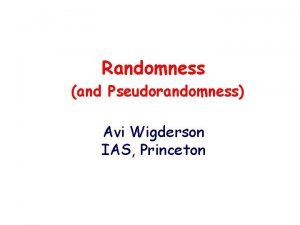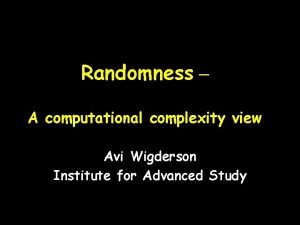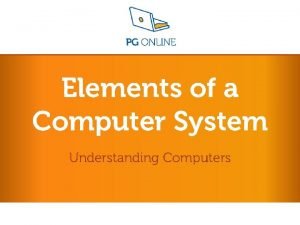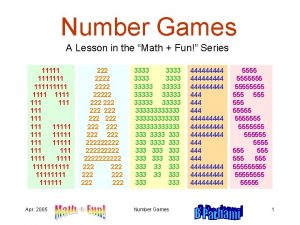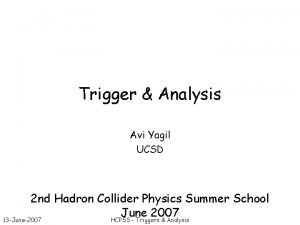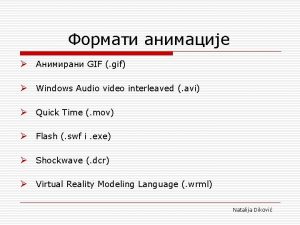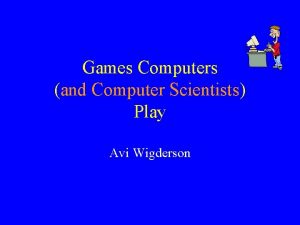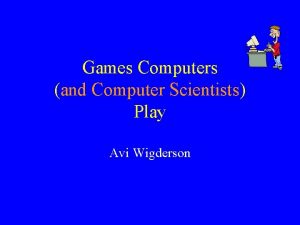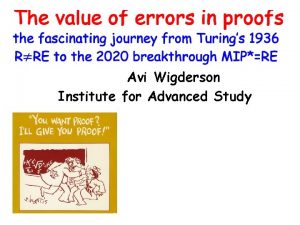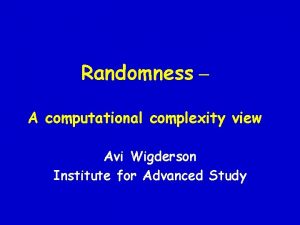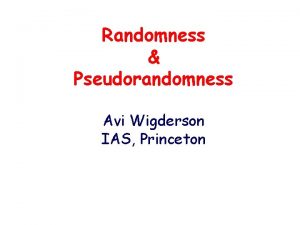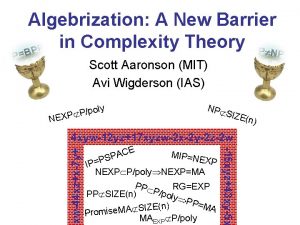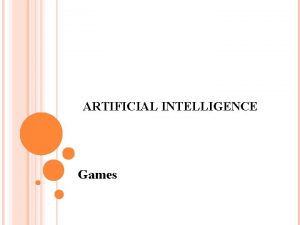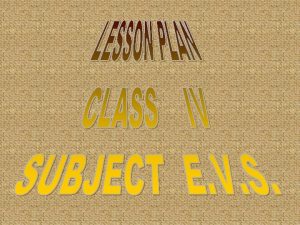Games Computers and Computer Scientists Play Avi Wigderson






![Theorem [Zermelo] : In every finite win/lose perfect information 2 -player game, White or Theorem [Zermelo] : In every finite win/lose perfect information 2 -player game, White or](https://slidetodoc.com/presentation_image_h2/4c232378694d5aa4ccad2011d398fc76/image-7.jpg)


![Nash Equilibrium Chicken [Aumann] C Probabilistic strategies (Sw, Sb). C D 11 20 Strategic Nash Equilibrium Chicken [Aumann] C Probabilistic strategies (Sw, Sb). C D 11 20 Strategic](https://slidetodoc.com/presentation_image_h2/4c232378694d5aa4ccad2011d398fc76/image-10.jpg)

![How to minimze players’ influence What is the best Function? Public Information Model [Ben-Or—Linial] How to minimze players’ influence What is the best Function? Public Information Model [Ben-Or—Linial]](https://slidetodoc.com/presentation_image_h2/4c232378694d5aa4ccad2011d398fc76/image-12.jpg)




![Competitive Analysis [Tarjan—Slator]: Bound the “competitive ratio”: muggle-cost(sequence) wizard-cost(sequence) Uniformly, over every sequence of Competitive Analysis [Tarjan—Slator]: Bound the “competitive ratio”: muggle-cost(sequence) wizard-cost(sequence) Uniformly, over every sequence of](https://slidetodoc.com/presentation_image_h2/4c232378694d5aa4ccad2011d398fc76/image-17.jpg)




![Joint random decisions Nash eq. with Independent Strategies Expected value = 3/4 Prob[CC] = Joint random decisions Nash eq. with Independent Strategies Expected value = 3/4 Prob[CC] =](https://slidetodoc.com/presentation_image_h2/4c232378694d5aa4ccad2011d398fc76/image-22.jpg)


![A Completeness Theorem [Yao, Goldreich –Micali –Wigderson]: 1: essential 1. More than 1/2 of A Completeness Theorem [Yao, Goldreich –Micali –Wigderson]: 1: essential 1. More than 1/2 of](https://slidetodoc.com/presentation_image_h2/4c232378694d5aa4ccad2011d398fc76/image-25.jpg)


![How to ensure Privacy Oblivious Computation [Yao] 1 f(inputs) P 1 1 0 M How to ensure Privacy Oblivious Computation [Yao] 1 f(inputs) P 1 1 0 M](https://slidetodoc.com/presentation_image_h2/4c232378694d5aa4ccad2011d398fc76/image-28.jpg)
![How to ensure Correctness Definition [Goldwasser-Micali-Rackoff]: zero-knowledge proofs: • Convincing • Reveal no information How to ensure Correctness Definition [Goldwasser-Micali-Rackoff]: zero-knowledge proofs: • Convincing • Reveal no information](https://slidetodoc.com/presentation_image_h2/4c232378694d5aa4ccad2011d398fc76/image-29.jpg)
![Where is Waldo? [Naor] Where is Waldo? [Naor]](https://slidetodoc.com/presentation_image_h2/4c232378694d5aa4ccad2011d398fc76/image-30.jpg)
![Completeness Theorem [Yao, Goldreich –Micali –Wigderson]: Computational 1. More than 1/2 are honest Cryptographic Completeness Theorem [Yao, Goldreich –Micali –Wigderson]: Computational 1. More than 1/2 are honest Cryptographic](https://slidetodoc.com/presentation_image_h2/4c232378694d5aa4ccad2011d398fc76/image-31.jpg)

- Slides: 32

Games Computers (and Computer Scientists) Play Avi Wigderson

Computer Science Games Game Theory = Information Processing by Computers Agents • • • Competing Cooperating Faulty Colluding Secretive Adversarial Computationally Bounded Communicating Digitally

Scientific / Mathematical/ Intellectual / Computational problems NP: Problems we want to solve/understand P: Problems we can efficiently solve/understand P=NP? - limits on human knowledge

Unsolvable PSPACE Chess // Go Go // many game Game strategies Computation is everywhere Solvable Ex Po cel in QP or SAT in mod pro el Pattern Integer Shortest vin ing Matching NP-complete g h & a Factoring Path ard lgo ne rith P Solving Theorem Error ss Sudoku Proving FFT Correction / l m de ow sig er Map n Multiplication b ou Coloring nd Addition s NP

Plan • • Complexity of Games Design of Games against Clairvoyance Implementation of Games

Complexity of Games Perfect information Which of these games do you prefer playing? Why?
![Theorem Zermelo In every finite winlose perfect information 2 player game White or Theorem [Zermelo] : In every finite win/lose perfect information 2 -player game, White or](https://slidetodoc.com/presentation_image_h2/4c232378694d5aa4ccad2011d398fc76/image-7.jpg)
Theorem [Zermelo] : In every finite win/lose perfect information 2 -player game, White or Black can force a win. Extensive Form Q: Why play Chess or Tic-Tac-Toe? Q: Can a winning strategy be efficiently computed? Q: Can you state/prove analogous thm for 3 players?

Rectangle Game m=4 n=5 1 m 1 5 2 4 3 Rules: Each player in turn removes a token, and all those (remaining) to its north or east. Player taking the Red token loses n Theorem: 1 st player has a winning strategy. Proof: Assume 2 nd has a winning strategy. Then White can mimic it and win. Contradiction! Question: What is the winning strategy? Question: Do you like this game? Why?

Zero-Sum Games Matching Pennies (simultaneous play) H H T Strategic Form 1 -1 -1 1 T -1 1 1 -1 “Best” strategy for each player is to flip a fair coin. Game value is 0. Question: Are “mixed” strategies reasonable? What is the source of randomness? Theorem [von Neumann ‘ 28]: Every 0 -sum game has a (Min-Max) value. 1 2 j 1 2 vij -vij i Question: Can the value, strategies be computed? n Theorem [Khachian ‘ 80]: Yes – Efficient linear programming algorithm. m
![Nash Equilibrium Chicken Aumann C Probabilistic strategies Sw Sb C D 11 20 Strategic Nash Equilibrium Chicken [Aumann] C Probabilistic strategies (Sw, Sb). C D 11 20 Strategic](https://slidetodoc.com/presentation_image_h2/4c232378694d5aa4ccad2011d398fc76/image-10.jpg)
Nash Equilibrium Chicken [Aumann] C Probabilistic strategies (Sw, Sb). C D 11 20 Strategic Form D 0 2 -3 -3 Nash Equilibrium: No player has an incentive to change its strategy given the opponent’s strategy. here Sw=Sb = [C with prob ¾, D with prob ¼] Theorem [Nash]: Every (matrix) game has an equilibrium. Question: Can the players compute (any) equilibrium? Best known algorithm: exponential time (infeasible). Theorem[Chen, Daskalakis, Papadimitriou]: PPAD-complete Question: Is Nash Eq. a good notion of a “rational solution”?

Designing Games
![How to minimze players influence What is the best Function Public Information Model BenOrLinial How to minimze players’ influence What is the best Function? Public Information Model [Ben-Or—Linial]](https://slidetodoc.com/presentation_image_h2/4c232378694d5aa4ccad2011d398fc76/image-12.jpg)
How to minimze players’ influence What is the best Function? Public Information Model [Ben-Or—Linial] : Joint random coin flipping Function Every good player flips, then the bad, Parity Majority then combine majority parity M M M P M Influence 1 1/7 Iterated Majority 1/8 M Theorem [Kahn—Kalai—Linial] : For every function, some player has non-proportional influence: >c(log n)/n Theorem [Alon—Naor] : There are “multi-round” functions for which no player has non-proportional influence: <c/n

How to achieve cooperation, efficiency, truthfulness Players (agents) are selfish • Auction Question: How to get players to bid their true values? Theorem [Clarke—Groves—Vickery]: 2 nd price auction achieves truthfulness. • Internet / Distributed Games Question: How to get players to cooperate? [Nisan]: Distributed algorithmic mechanism design. [Papadimitriou]: Algorithms, Games & the Internet, Price of anarchy, complexity classes New CS Issues: Pricing, incentives New GT Issues: Complexity, Algorithms

Coping with Uncertainty Competing against Clairvoyance

On-line Problems Investor’s Problem (One-way trading) price 1 Muggle’s action Wizard’s action 2 3 4 5 6 7 8 9 day Profit/loss

On-line problems are everywhere: • Computer operating systems • Taxi/Uber dispatchers • Investors’ decisions • Battle decisions • Weather prediction • • • Question: How to measure quality of on-line algs?
![Competitive Analysis TarjanSlator Bound the competitive ratio mugglecostsequence wizardcostsequence Uniformly over every sequence of Competitive Analysis [Tarjan—Slator]: Bound the “competitive ratio”: muggle-cost(sequence) wizard-cost(sequence) Uniformly, over every sequence of](https://slidetodoc.com/presentation_image_h2/4c232378694d5aa4ccad2011d398fc76/image-17.jpg)
Competitive Analysis [Tarjan—Slator]: Bound the “competitive ratio”: muggle-cost(sequence) wizard-cost(sequence) Uniformly, over every sequence of events Can be achieved in many settings. Huge, successful theory. “Online Computation and Competitive Analysis” [Borodin—El-Yaniv] May be viewed as a repeated, 2 player game: An adversary, generating the sequence, and the muggle, responding to it!

The ski problem Problem: Rent or buy? Renting a pair of skis for 1 day: $100 Buying a pair of skis, for life: $1000 Day 1: ? Day 2: ? … … How many days D you’ll ski is uknown to Muggle, known to Wizard Muggle’s action: Rent for 9 days. On day 10 buy. Wizard’s action: If D>9, buy on Day 1. Else rent every day. Competitive ratio: <2 (if D=10, W pays $1000, M pays $1900)

Doing as well as the best of (k) experts Reality E 1, E 2, …. , Ek Day 0: Day 1: Day 2: Day 3: … Make as few prediction errors as possible Muggle

Implementing Games Q: Many games (and interactions) have rules / constraints – can they be played /implemented (eg on the phone, Internet)? The power of cryptography (and beyond)

The Millionaires’ Problem A Alice B Bob Both want to know who is richer Neither gets any other information Question: Is that possible?
![Joint random decisions Nash eq with Independent Strategies Expected value 34 ProbCC Joint random decisions Nash eq. with Independent Strategies Expected value = 3/4 Prob[CC] =](https://slidetodoc.com/presentation_image_h2/4c232378694d5aa4ccad2011d398fc76/image-22.jpg)
Joint random decisions Nash eq. with Independent Strategies Expected value = 3/4 Prob[CC] = 9/16 Prob[CD] = 3/16 Prob[DC] = 3/16 Prob[DD] = 1/16 3/4 C 3/4 1/4 C D 11 20 1/4 D 0 2 -3 -3 Nash eq. with Correlated Strategies [Aumann] Prob[CD] = 1/2 Prob[DC] = 1/2 Prob[CC] = 0 Prob[DD] = 0 Expected value = 1 Question: How to flip a coin jointly?

Simultaneity 1/2 H Expected value = 0 (if they play simultaneously) T 1 -1 -1 1 1/2 H 1/2 T -1 1 1 -1 Question: How do we guarantee simultaneity? A computational representation: Parity Function outcome P x. W x. B Parity(x. W, x. B ) 0 1 0 1 1 0 0 0 1 1

Privacy vs. Resilience • Voting Majority Function M x 1 x 2 x 3 Majority(x 1, x 2, x 3 ) 0 0 0 1 1 1 0 0 1 0 1 0 0 0 0 1 1 Q 1: How to guarantee x 1 5? Q 2: How to guarantee x 1 remains private? • Millionaire’s Problem • Poker • Any game
![A Completeness Theorem Yao Goldreich Micali Wigderson 1 essential 1 More than 12 of A Completeness Theorem [Yao, Goldreich –Micali –Wigderson]: 1: essential 1. More than 1/2 of](https://slidetodoc.com/presentation_image_h2/4c232378694d5aa4ccad2011d398fc76/image-25.jpg)
A Completeness Theorem [Yao, Goldreich –Micali –Wigderson]: 1: essential 1. More than 1/2 of the players are honest 2+3: crypto 2. Players computationally bounded 3. Trap-door functions exist (e. g. factoring integers is hard) Every game, with any secrecy requirements, can be digitally implemented s. t. no collusion of the bad players can affect: * correctness (rules, outcome) * privacy (no information leaks) Hard problems can be useful!

Every Game? Any secrecy requirements? Incomplete information Game in Extensive form Nature Alice Bob . . . Nature Alice. . . Information Sets • Player’s action depends only on its information set

Correct & Private digital implementation Trusted party Ideal implementation Secrets Preferences Strategies s 1 s 2 sn 1 2 n Internet Digital implementation Simulation paradigm: The two are indistinguishable Internet
![How to ensure Privacy Oblivious Computation Yao 1 finputs P 1 1 0 M How to ensure Privacy Oblivious Computation [Yao] 1 f(inputs) P 1 1 0 M](https://slidetodoc.com/presentation_image_h2/4c232378694d5aa4ccad2011d398fc76/image-28.jpg)
How to ensure Privacy Oblivious Computation [Yao] 1 f(inputs) P 1 1 0 M P 1 1 0 P M P 1 0 0 1 0
![How to ensure Correctness Definition GoldwasserMicaliRackoff zeroknowledge proofs Convincing Reveal no information How to ensure Correctness Definition [Goldwasser-Micali-Rackoff]: zero-knowledge proofs: • Convincing • Reveal no information](https://slidetodoc.com/presentation_image_h2/4c232378694d5aa4ccad2011d398fc76/image-29.jpg)
How to ensure Correctness Definition [Goldwasser-Micali-Rackoff]: zero-knowledge proofs: • Convincing • Reveal no information Theorem [Goldreich-Micali-Wigderson]: Every provable mathematical statement has a zero-knowledge proof. Corollary: Players can be forced to act legally, without fear of compromising their secrets.
![Where is Waldo Naor Where is Waldo? [Naor]](https://slidetodoc.com/presentation_image_h2/4c232378694d5aa4ccad2011d398fc76/image-30.jpg)
Where is Waldo? [Naor]
![Completeness Theorem Yao Goldreich Micali Wigderson Computational 1 More than 12 are honest Cryptographic Completeness Theorem [Yao, Goldreich –Micali –Wigderson]: Computational 1. More than 1/2 are honest Cryptographic](https://slidetodoc.com/presentation_image_h2/4c232378694d5aa4ccad2011d398fc76/image-31.jpg)
Completeness Theorem [Yao, Goldreich –Micali –Wigderson]: Computational 1. More than 1/2 are honest Cryptographic 2. Players computationally bounded 3. Trap-door functions exist (e. g. factoring integers is hard) Every game, with any secrecy requirements, can be digitally implemented s. t. no collusion of the bad players can affect: * correctness (rules, outcome) * privacy (no information leaks) Theorem [Ben-Or –Goldwasser –Wigderson]: 1’. More than 2/3 are honest 2’. 3’. Private pairwise communication Informationtheoretic

Book ad - Published by Princeton University Press - Free (forever) on my website - Comments welcome!
 Ias princeton math
Ias princeton math Avi wigderson
Avi wigderson Avi wigderson princeton
Avi wigderson princeton Avi wigderson
Avi wigderson Avi wigderson
Avi wigderson Types of games outdoor
Types of games outdoor Hunger games questions and answers
Hunger games questions and answers Computer applications - understanding computers unit
Computer applications - understanding computers unit Basic structure of computers
Basic structure of computers Go.education city
Go.education city Taino homes
Taino homes Games play with friends
Games play with friends 20個問題遊戲
20個問題遊戲 Twenty questions text games
Twenty questions text games Avi file format advantages and disadvantages
Avi file format advantages and disadvantages I've got a friend we like to play we play together
I've got a friend we like to play we play together Play random play basketball
Play random play basketball Play by play
Play by play Hamlet kim
Hamlet kim Avi yagil
Avi yagil Pantanal avi
Pantanal avi Nothing but the truth avi
Nothing but the truth avi What is the theme of nothing but the truth
What is the theme of nothing but the truth Audio visual gif
Audio visual gif Jessica.avi
Jessica.avi Ragweed by avi lesson plans
Ragweed by avi lesson plans Pantanal avi
Pantanal avi Avi solar energy pvt ltd
Avi solar energy pvt ltd Something upstairs
Something upstairs Avi pfeffer
Avi pfeffer Kari lehtola avi
Kari lehtola avi Esavi
Esavi Sup . avi
Sup . avi


